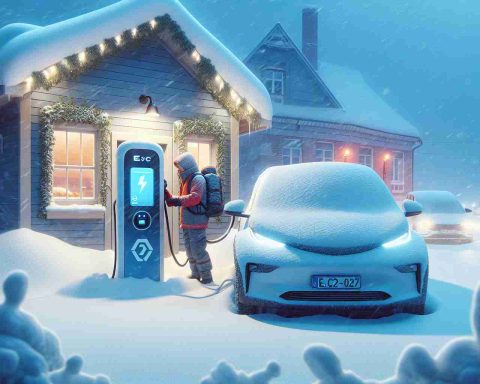Mastering Winter Driving for Your Electric Vehicle
As winter’s chill encroaches, electric vehicle (EV) drivers may wonder how to navigate the season without diminishing performance. Experts in the field have provided valuable insights on maximizing range and efficiency during these cold months.
Consider Indoor Parking
Whenever possible, park your electric vehicle in a garage. Even an unheated garage can shield your EV from extreme temperatures. A slight temperature increase can help the battery maintain its charge longer, as EV batteries tend to lose efficiency with every drop in temperature.
Plan Your Departures
Scheduling your trips smartly allows you to precondition your vehicle. By warming the battery ahead of your journey, you can optimize your range. Apps like those provided by managed charging services can help you set these preferences effortlessly.
Charge Wisely
To ensure you start each day with maximum range, aim to fully charge your EV at home overnight. Charging strategies are crucial during colder months, helping mitigate the effects of reduced range.
Utilize Eco Mode
Switching to Eco Mode can significantly enhance efficiency, although it might limit features like acceleration. Additionally, keeping the vehicle’s heating system at a lower setting can conserve energy.
Stay vigilant by planning charging stops on longer trips, and always prepare for emergencies with essential supplies. Ready your electric vehicle for winter and enjoy the ride!
The Broader Impact of Electric Vehicle Winter Preparedness
As the adoption of electric vehicles (EVs) continues to grow, the importance of understanding their performance in winter conditions has far-reaching implications for society and the global economy. EV ownership is becoming synonymous with environmental consciousness, but the transition to a winter-friendly driving culture is crucial for maximizing the ecological benefits of these vehicles. By enabling efficient winter driving practices, we are taking steps toward sustainability that can reduce the carbon footprint traditionally linked with winter fuel consumption in internal combustion engines.
Culturally, the integration of EVs into everyday life shapes new norms around transportation and environmental responsibility. As more drivers prioritize battery care, the conversation shifts from merely owning an EV to embracing a lifestyle that supports ongoing performance and sustainability. This shift could prompt adaptations in urban infrastructure, leading to increased investments in charging stations and improved vehicle service that accommodates winter-specific needs.
In the broader economic landscape, the electric vehicle market is anticipated to flourish, with forecasts predicting it could exceed $800 billion by 2027. This shift will not only spur job creation in tech and manufacturing sectors but could also stimulate growth in renewable energy systems to support the demands of increased EV usage.
As we look to the future, the intersection of environmental stewardship and technological advancement suggests a pathway where winter preparedness contributes to a more robust global EV ecosystem. Emphasizing comprehensive winter strategies ensures that the continued proliferation of electric vehicles remains viable and effective, fostering a healthier planet for generations to come.
Conquer Winter Roads: Essential Tips for Electric Vehicle Owners
Mastering Winter Driving for Your Electric Vehicle
As winter approaches, electric vehicle (EV) owners need to adapt their driving habits to mitigate the challenges posed by cold weather. Here, we provide essential tips, innovations, and insights to help you optimize your EV’s performance during the winter months.
# Features to Enhance Winter Driving
1. Heat Pump Technology
Modern EVs often come equipped with heat pump systems that provide efficient cabin heating and cabin preconditioning without greatly impacting battery range. This technology can significantly reduce energy consumption in cold weather, enhancing overall performance.
2. Regenerative Braking
Utilizing regenerative braking can also help in winter driving. Not only does this feature maximize range by recapturing energy during deceleration, but it also provides added traction under slick conditions, especially when driving downhill.
3. Tire Options
Consider investing in winter tires specifically designed for electric vehicles. These tires offer better grip and handling performance in snow and ice, thus enhancing safety. Some EVs may even come with tire pressure monitoring systems that help maintain optimal tire pressure, which can drop significantly in colder temperatures.
# Pros and Cons of Electric Vehicles in Winter
Pros:
– Instant Torque: Electric motors deliver instant torque, which can be advantageous for traction in slippery conditions.
– Low Center of Gravity: The weight distribution of EVs typically results in better stability on icy roads.
Cons:
– Reduced Range: Cold weather can decrease battery efficiency, resulting in a diminished driving range.
– Longer Charging Times: Charging an EV in cold temperatures can be slower, and the need for frequent stops may disrupt travel plans.
# How to Maximize Your EV’s Winter Performance
1. Precondition Your Vehicle
Use your mobile app to precondition your EV while it’s still plugged in. This practice warms both the battery and cabin, substantially improving range before you even hit the road.
2. Monitor Battery Health
Keeping an eye on battery health through your vehicle’s diagnostic tools can signal potential issues exacerbated by winter conditions.
3. Utilize Regenerative Braking Wisely
Adjust the regenerative braking settings to allow for smoother transitions while ensuring optimal control in icy conditions. Keeping regenerative braking on too high can lead to skidding.
# Trends and Innovations in Winter EV Driving
– Smart Charging Stations: Many urban areas are beginning to introduce charging stations designed for cold weather, with heaters that maintain optimal temperature for efficient charging.
– Vehicle-to-Grid Technology: Some newer EV models allow driver owners to channel power back to the grid, which could be utilized during peak demand in winter, showing sustainability trends in energy use.
# Pricing Considerations
With the rise in electric vehicles, prices can fluctuate significantly based on features and battery technology. It’s advisable to monitor local market trends to secure the best deal on winter-ready EV models and aftermarket accessories.
# Sustainability Aspects
Investing in electric vehicles during winter aligns with broader sustainability goals. With renewable energy sources increasingly powering charging stations, utilizing electric vehicles effectively during winter months promotes a decrease in overall carbon emissions.
For more information on electric vehicle tips and best practices, visit Edmunds.
By incorporating these tips and innovations, EV drivers can navigate the winter roads safely and efficiently, ensuring a smooth driving experience no matter how cold it gets.









